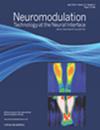深入分析骶神经调控中的盆底运动反应并将其与疗效联系起来
IF 3.2
3区 医学
Q2 CLINICAL NEUROLOGY
引用次数: 0
摘要
目的:本研究旨在描述骶神经调控(SNM)编程过程中引发的盆底肌肉(PFM)运动反应:本研究旨在描述在骶神经调控(SNM)编程过程中引发的盆底肌肉(PFM)运动反应,确定其在改善治疗效果方面的作用:这项前瞻性研究(2018 年 1 月至 2021 年 9 月)纳入了接受单侧骶神经调控的膀胱过度活动症(OAB)或非梗阻性尿潴留(NOUR)患者。外部脉冲发生器连接三周。成功的定义是改善≥50%。对感觉阈值(ST)、运动阈值(MT)及其比率(MT-ST)进行了分析。使用多阵列探头记录 PFM 肌电图。使用 ST、MT、MT-ST 和平均自然对数转换(峰-峰振幅)与结果(改善百分比)进行线性回归模型分析。使用线性混合模型分析法(LMM)对不同电刺激水平(ST ± 0.5 mA)和盆底不同部位(四侧、三深)的电动 PFM 运动反应幅度差异进行建模:研究对象包括 64 名女性(总体成功率为 80%)。应答者的 MT 和 MT-ST 明显较低(非配对 t 检验:p = 0.0271 和 p = 0.0158)。MT 和 MT-ST 与改善百分比有显著关系(线性回归 [lin. Regr.] p = 0.0304,R2 = 0.0745 和 lin.P = 0.0107,R2 = 0.1020)。PFM 振幅与所有刺激振幅(ST ± 0.5 mA)(线性回归 p < 0.0001,R2 = 0.2560)和亚感觉刺激强度(线性回归 p = 0.0008,R2 = 0.1673)的改善百分比有显著关系。随着刺激强度的增加,应答者的总体峰-峰振幅也呈现出不同的变化(LMM:p = 0.0160),斜率明显更高。这与所有不同侧面和深度的改善百分比有明显不同,对侧上部是唯一的例外(LMM:p = 0.0071,范围:0.0663-结论):0.0663-结论:研究发现,单侧骶脊神经刺激引起的疗效和 PFM 运动反应之间存在明显的相关性,并将导联位置和 SNM 结果联系起来。与无反应者相比,有反应者的 MTs、MT-STs、复合肌肉动作电位较低,其 PFM 在亚感觉刺激水平上的持续激活程度较高。本文章由计算机程序翻译,如有差异,请以英文原文为准。
A Deep Analysis of the Pelvic Floor Motor Response in Sacral Neuromodulation Linking It to Outcome
Objectives
This study aimed to characterize the pelvic floor muscles (PFM) motor response provoked during sacral neuromodulation (SNM) programming, determining its utility in improving therapy delivery.
Materials and Methods
This prospective study (January 2018–September 2021) included patients with overactive bladder (OAB) or nonobstructive urinary retention (NOUR) who underwent unilateral SNM. An external pulse generator was connected for three weeks. Success was defined as ≥50% improvement. Sensory threshold (ST), motor threshold (MT), and their ratio (MT-ST) were analyzed. PFM electromyography was recorded using a multiple array probe. A linear regression model with ST, MT, MT-ST, and mean natural log transformation (peak-to peak-amplitude) vs outcome (percentage improvement) was performed. Differences in electrical PFM motor response amplitude between different electrical stimulation levels (ST ± 0.5 mA) and different parts (four sides, three depths) of the pelvic floor were modeled using linear mixed model analysis (LMM).
Results
The study population comprised 64 women (overall success 80%). Responders presented with significantly lower MT and MT-ST (unpaired t-test: p = 0.0271 and p = 0.0158, respectively). MT and MT-ST proved a significant relationship with percentage improvement (linear regression [lin. Regr.] p = 0.0304, R2 = 0.0745 and lin. Regr. p = 0.0107, R2 = 0.1020, respectively). PFM amplitude showed a significant relationship with percentage improvement for all stimulation amplitudes (ST ± 0.5 mA) (lin. Regr. p < 0.0001, R2 = 0.2560), and subsensory stimulation intensities (lin. Regr. p = 0.0008, R2 = 0.1673). Responders presented with a different evolution in increase in overall peak-to-peak amplitude over increased stimulation intensities (LMM: p = 0.0160), presenting with a significantly higher slope. This was significantly different depending on the percentage improvement for all the different sides and depths, with contralateral superior being the only exception (LMM: p = 0.0071, range: 0.0663–<0.0001).
Conclusions
A clear correlation was found between therapy efficacy and PFM motor response elicited by unilateral sacral spinal nerve stimulation, linking lead placement and SNM outcome. Responders presented with lower MTs, lower MT-STs, higher compound muscle action potentials, and higher continuous activation of their PFM at subsensory stimulation levels than did nonresponders.
求助全文
通过发布文献求助,成功后即可免费获取论文全文。
去求助
来源期刊

Neuromodulation
医学-临床神经学
CiteScore
6.40
自引率
3.60%
发文量
978
审稿时长
54 days
期刊介绍:
Neuromodulation: Technology at the Neural Interface is the preeminent journal in the area of neuromodulation, providing our readership with the state of the art clinical, translational, and basic science research in the field. For clinicians, engineers, scientists and members of the biotechnology industry alike, Neuromodulation provides timely and rigorously peer-reviewed articles on the technology, science, and clinical application of devices that interface with the nervous system to treat disease and improve function.
 求助内容:
求助内容: 应助结果提醒方式:
应助结果提醒方式:


